The T cells in peripheral taste tissue of healthy human adults: predominant memory T cells and Th-1 cells
- PMID: 20457570
- PMCID: PMC2885746
- DOI: 10.1093/chemse/bjq040
The T cells in peripheral taste tissue of healthy human adults: predominant memory T cells and Th-1 cells
Abstract
A healthy taste system is important to the maintenance of nutrition and overall quality of life, and taste disorders are associated with many inflammatory states. We previously determined the immune cells in normal human gustatory tissue; they are predominantly dendritic cells and CD4 T cells with a few macrophages and B lymphocytes present. There are, however, few reports of the subtypes of resident lymphocytes in or near taste tissues. The present study further characterized the distribution and population of the major subtypes of T cells in situ within biopsies of healthy human fungiform papillae (FP). Immunohistochemical analyses indicated that T-helper (Th)1 cells (CCR5+) were more predominant in FP than Th2 T cells (CCR4+). CD45RO+ memory T cells were the principal T cells in gustatory tissue, whereas CD45RA+ naive T cells were uncommon. Regarding subcompartments of the tissue, most intraepithelial lymphocytes of FPs were gamma/delta T cells, whereas the major subtype of lymphocytes in the lamina propria were alpha/beta T cells. Regulatory T cells that express CTLA-4 (CD152) and interleukin-2 receptors (IL-2R, CD25) were found at low levels in FP. The T cells stand ready to respond to inflammatory and infectious insults and may play a role in the taste alterations observed during acute and chronic inflammatory states.
Figures
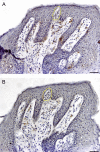
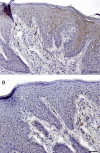
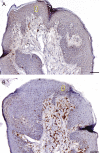
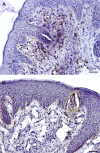
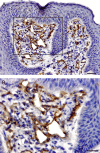
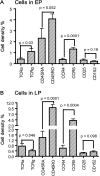
Similar articles
-
Immune cells of the human peripheral taste system: dominant dendritic cells and CD4 T cells.Brain Behav Immun. 2009 Aug;23(6):760-6. doi: 10.1016/j.bbi.2009.02.016. Epub 2009 Mar 4. Brain Behav Immun. 2009. PMID: 19268521 Free PMC article.
-
C-C chemokine receptor 4 expression defines a major subset of circulating nonintestinal memory T cells of both Th1 and Th2 potential.J Immunol. 2001 Jan 1;166(1):103-11. doi: 10.4049/jimmunol.166.1.103. J Immunol. 2001. PMID: 11123282
-
CD4+CD25+Foxp3+ T regulatory cells, Th1 (CCR5, IL-2, IFN-γ) and Th2 (CCR4, IL-4, Il-13) type chemokine receptors and intracellular cytokines in children with common variable immunodeficiency.Int J Immunopathol Pharmacol. 2016 Jun;29(2):241-51. doi: 10.1177/0394632015617064. Epub 2015 Dec 18. Int J Immunopathol Pharmacol. 2016. PMID: 26684629 Free PMC article.
-
Differential expression of the chemokine receptors by the Th1- and Th2-type effector populations within circulating CD4+ T cells.J Leukoc Biol. 2000 Oct;68(4):568-74. J Leukoc Biol. 2000. PMID: 11037980
-
T helper cells plasticity in inflammation.Cytometry A. 2014 Jan;85(1):36-42. doi: 10.1002/cyto.a.22348. Epub 2013 Sep 5. Cytometry A. 2014. PMID: 24009159 Review.
Cited by
-
Regulation of bitter taste responses by tumor necrosis factor.Brain Behav Immun. 2015 Oct;49:32-42. doi: 10.1016/j.bbi.2015.04.001. Epub 2015 Apr 21. Brain Behav Immun. 2015. PMID: 25911043 Free PMC article.
-
Immune responses in the injured olfactory and gustatory systems: a role in olfactory receptor neuron and taste bud regeneration?Chem Senses. 2022 Jan 1;47:bjac024. doi: 10.1093/chemse/bjac024. Chem Senses. 2022. PMID: 36152297 Free PMC article. Review.
-
Type II taste cells participate in mucosal immune surveillance.PLoS Biol. 2023 Jan 12;21(1):e3001647. doi: 10.1371/journal.pbio.3001647. eCollection 2023 Jan. PLoS Biol. 2023. PMID: 36634039 Free PMC article.
-
Adaptive immune cells shape obesity-associated type 2 diabetes mellitus and less prominent comorbidities.Nat Rev Endocrinol. 2022 Jan;18(1):23-42. doi: 10.1038/s41574-021-00575-1. Epub 2021 Oct 26. Nat Rev Endocrinol. 2022. PMID: 34703027 Free PMC article. Review.
-
Interleukin-10 is produced by a specific subset of taste receptor cells and critical for maintaining structural integrity of mouse taste buds.J Neurosci. 2014 Feb 12;34(7):2689-701. doi: 10.1523/JNEUROSCI.3074-13.2014. J Neurosci. 2014. PMID: 24523558 Free PMC article.
References
-
- Abdollahi M, Radfar M. A review of drug-induced oral reactions. J Contemp Dent Pract. 2003;4(1):10–31. - PubMed
-
- Acuto O, Reinherz EL. The human T-cell receptor. Structure and function. N Engl J Med. 1985;312(17):1100–1111. - PubMed
-
- Baudouin C, Liang H, Bremond-Gignac D, Hamard P, Hreiche R, Creuzot-Garcher C, Warnet JM, Brignole-Baudouin F. CCR 4 and CCR 5 expression in conjunctival specimens as differential markers of T(H)1/ T(H)2 in ocular surface disorders. J Allergy Clin Immunol. 2005;116(3):614–619. - PubMed
-
- Breslin PA, Chapman GB, Mattes RD, Beauchamp GK, Cowart BJ. Quality of life for patients with chemical senses disorders. Chem Senses. 1997;22:650.
-
- Campbell JD, HayGlass KT. T cell chemokine receptor expression in human Th1- and Th2-associated diseases. Arch Immunol Ther Exp (Warsz) 2000;48(6):451–456. - PubMed
Publication types
MeSH terms
Substances
Grants and funding
LinkOut - more resources
Full Text Sources
Research Materials
Miscellaneous

